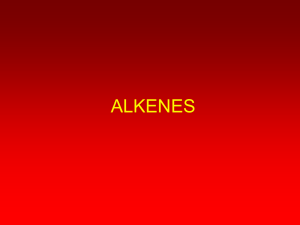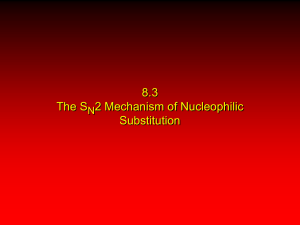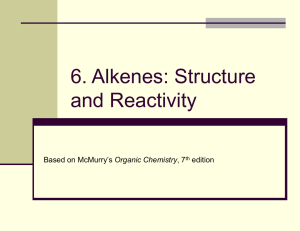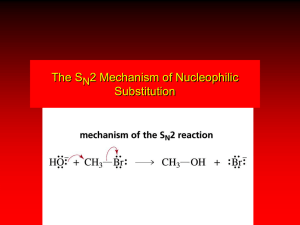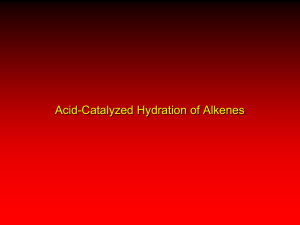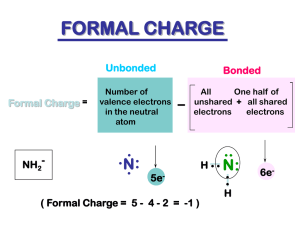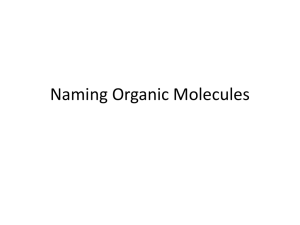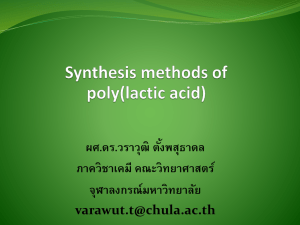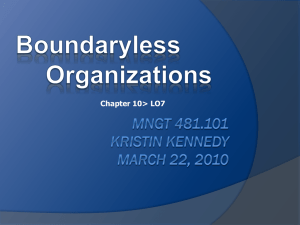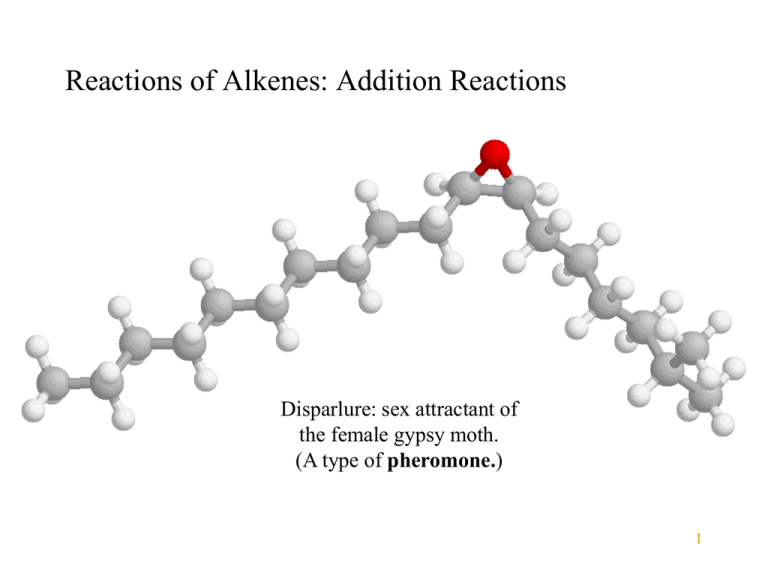
Reactions of Alkenes: Addition Reactions
Disparlure: sex attractant of
the female gypsy moth.
(A type of pheromone.)
1
Y
C
C
+
Y
Z
C
Z
Addition
Reactions
C
I. Hydrogenation of Alkenes
C
C
+
H2
P t, P d,
or N i
catalyst
H
H
C
C
O
oleic acid
(unsaturated)
OH
H 2, N i
O
OH
stearic acid
(saturated)
2
I. Hydrogenation of Alkenes
A. Heats of hydrogenation
C
C
+
H2
H
H
C
C
Pt
DHº ~ -30 kcal/mol
DHº
-30.1 kcal
-28.1
-27.2
More substituted more stable.
-27.8
-26.7
3
I. Hydrogenation of Alkenes
A. Heats of hydrogenation
30.1
less stable
28.1
27.8
27.2
26.7
0
more stable
0
4
I. Hydrogenation of Alkenes
B. Stereochemistry of hydrogenation
Y
YZ
C
C
C
C
Y
Z
C
C
YZ
Z
anti addition
syn addition
Catalytic hydrogenation proceeds by syn addition:
H2
Pt
CH3
H
H
CH3
5
I. Hydrogenation of Alkenes
Question 6-1. Give the product of the following reaction. Click on
the arrow to check your answer.
H2
Pt
Check Answer
6
I. Hydrogenation of Alkenes
Answer 6-1. Give the product of the following reaction. Click on the
arrow to check your answer.
H2
H
H
Pt
7
II. Electrophilic Addition
“Loose” p electrons are nucleophilic (Lewis bases),
react with electrophiles (Lewis acids).
electro p h ile
+ Y Z
Z
Y
C
C
C
C
Y
Z
C
C
n u cleo p h ile
8
II. Electrophilic Addition
A. Addition of hydrogen halides
C
+
C
H
X
H
X
C
C
(X = Cl, Br, I)
Reactivity: HI > HBr > HCl >> HF (stronger acid = better electrophile)
+ H X
X
H
C
C
C
C
RLS
fast
H
X
C
C
HBr
Br
HI
I
9
II. Electrophilic Addition
A. Addition of hydrogen halides
1. Markovnikov’s rule
In the addition of HX to an alkene, the H goes to the carbon with more H’s.
CH3
CH
CH2
Br
HBr
CH3
CH
CH3
but not
CH3
CH2
CH2
Br
Question 6-2. Draw the products. Click on the arrow to check answers.
HI
HCl
HBr
Check Answer
HI
10
II. Electrophilic Addition
A. Addition of hydrogen halides
1. Markovnikov’s rule
In the addition of HX to an alkene, the H goes to the carbon with more H’s.
CH3
CH
CH2
Br
HBr
CH3
CH
CH3
but not
CH3
CH2
CH2
Answer 6-2.
HI
I
Cl
HCl
HBr
Br
I
HI
and
I
11
Br
II. Electrophilic Addition
A. Addition of hydrogen halides
2. mechanism
H
CH3
CH
Br
CH2
CH3
CH
CH3
Br
Br
2º carbocation
m ore stable
CH3
CH2
CH2
Br
Br
1º carbocation
less stable
Mechanistic interpretation of Markovnikov’s rule: The reaction proceeds
through the more stable carbocation intermediate.
12
II. Electrophilic Addition
A. Addition of hydrogen halides
2. mechanism
lower Ea
faster rate of
formation
Br
Br
Br
+ HBr
Br
13
II. Electrophilic Addition
A. Addition of hydrogen halides
3. carbocation rearrangements
HBr
+
Br
Br
HBr
Br
H
Br
1 ,2-H sh ift
Br
Br
14
II. Electrophilic Addition
A. Addition of hydrogen halides
3. carbocation rearrangements
HCl
+
Cl
Cl
Question 6-3. Give the expected major product for each reaction. Click on
the arrow to check answers.
HBr
HCl
Check Answer
HCl
15
II. Electrophilic Addition
A. Addition of hydrogen halides
3. carbocation rearrangements
Answer 6-3. Give the expected major product for each reaction. Click on
the arrow to check answers.
HBr
Br
forms tertiary carbocation- no need for
rearrangement.
Cl
forms secondary carbocation, rearranges to
a tertiary carbocation via a hydride shift
HCl
HCl
Cl
forms a secondary carbocation, rearranges to
a tertiary carbocation via a methide shift
16
II. Electrophilic Addition
A. Addition of hydrogen halides
4. free-radical addition of HBr
no
+ HBr
p ero x id es
p ero x id es
Markovnikov
orientation
Br
Br
antiMarkovnikov
orientation
(peroxide effect)
17
II. Electrophilic Addition
A. Addition of hydrogen halides
4. free-radical addition of HBr
Free radical chain mechanism:
R
O
O
D
R
2 RO
Initiation
RO
ROH + Br
+ HBr
Br
C
+
C
Br
C
C
Propagation
Br
C
n et:
+ HBr
C
C
C
+ HBr
Br
H
C
C
Br
H
C
C
+ Br
18
II. Electrophilic Addition
A. Addition of hydrogen halides
4. free-radical addition of HBr
HBr
Br
Br
3º
Br
Br
Reaction proceeds through
more stable radical intermediate.
1º
19
II. Electrophilic Addition
A. Addition of hydrogen halides
4. free-radical addition of HBr
Compare: addition of HBr with and without peroxides
Br
HBr
Markovnikov
orientation
Br
(H + )
More stable intermediate
in both cases.
HBr
p erox
(B r )
Br
HBr
Br
antiMarkovnikov
orientation
Regiochemical control
20
II. Electrophilic Addition
A. Addition of hydrogen halides
Question 6-5. Give the major products of the following reactions. Click on
the arrow to check your answer.
HBr
HBr
perox ides
HBr
HBr
p ero xid es
Check Answer
21
II. Electrophilic Addition
A. Addition of hydrogen halides
Answer 6-5. Give the major products of the following reactions.
HBr
goes Markovnikov via
electrophilic reaction
Br
HBr
Br
perox ides
HBr
HBr
p ero xid es
Br
goes anti-Markovnikov
via radical reaction
rearranges to more
stable carbocation
Br
goes anti-Mark via free
radical, no rearrangement
22
II. Electrophilic Addition
B. Addition of sulfuric acid (industrial)
C
C
+ H 2S O 4
H
O S O 3H
C
C
D
alkyl hydrogen
sulfate
H 2S O 4
O S O 3H
H 2O
H 2O
H
OH
C
C
overall:
hydration
OH
D
Markovnikov
orientation
23
II. Electrophilic Addition
C. Acid-catalyzed hydration
C
C
+ H 2O
H
H
+
C
OH
reverse of dehydration
(Le Châtelier)
C
OH
H 2O
Markovnikov
H 2S O 4
H+
H 2O
-H +
-H 2 O
OH2
-H +
OH
H+
Principle of microscopic reversibility
24
II. Electrophilic Addition
D. Addition of halogens
C
C
+ X2
X
X
C
C
(X = Cl or Br)
a vicinal dihalide
Stereoselective anti addition:
Br
B r2
trans only
C C l4
Br
25
II. Electrophilic Addition
D. Addition of halogens
Mechanism: halonium ions
Br
Br
Br
Br
C
C
C
C
C
C
Br
Br
cyclic bromonium ion
Br
Br
Br
Br
trans product
Br
Br
anti addition
26
II. Electrophilic Addition
E. Formation of halohydrins
C
X2
C
H 2O
X
OH
C
C
+ HX
vicinal halohydrin
Br
Br
Br
Br
C
C
C
C
C
Br
-H +
C
OH2
C
C
OH
H 2O
anti addition
B r2
Br
H 2O
27
OH
II. Electrophilic Addition
E. Formation of halohydrins
Cl
C l2
Regioselective:
OH
but not
H 2O
OH
Cl
Cl
Cl
Cl
Cl
larger
contributor
than 1º cation
m ajor
contributor
Cl
28
II. Electrophilic Addition
E. Formation of halohydrins
Cl
Cl
resonance hybrid:
+
+
OH2
OH2
more substituted C carries greater +,
has stronger attraction for nucleophile
29
II. Electrophilic Addition
E. Formation of halohydrins
Other nucleophiles:
CH3
B r2
OCH3
C H 3O H
Br
-H +
Br
Br
CH3
Br
O
CH3
H
Br
C H 3O H
30
II. Electrophilic Addition
E. Formation of halohydrins
Question 6-8. Give the products, showing stereochemistry where
applicable. Click on the arrow to check your answers.
B r2
C C l4
B r2
H 2O
B r2
C H 3C H 2O H
B rC l
Check Answer
C C l4
31
II. Electrophilic Addition
E. Formation of halohydrins
Answer 6-8. Give the products, showing stereochemistry where
applicable. Click on the arrow to check your answers.
Br- is nucleophile
B r2
C C l4
Br
Br
B r2
H 2O
OH
H2O is nucleophile
Br
B r2
C H 3C H 2O H
O C H 2C H 3
Br
B rC l
C C l4
Ethanol is nucleophile
Br
Cl
Interesting! Br+ is electrophile,
since it is less electronegative;
Cl- is nucleophile.
32
III. Other Reactions of Alkenes
A. Hydroboration-oxidation
C
C
R 2B H
a boron
hydride
6
+ B 2H 6
H
BR2
C
C
H 2O 2
OH-
an organoborane
2
)3 B
H
OH
C
C
antiMarkovnikov orientation
stereoselective syn addition
no rearrangements
H 2O 2
OH
-
6
O H + 2 B (O H ) 3
CH3
1) B 2 H 6
2) H 2 O 2 , O H -
H
anti-Markovnikov
syn addition
OH
33
III. Other Reactions of Alkenes
A. Hydroboration-oxidation
Mechanism:
- +
H BH2
2 BH3
b o rane
B 2H 6
d ib orane
m o re
electro p ositiv e
than H
- +
H BH2
CH3
CH
CH2
H
CH3
CH
+
BH2
CH2
CH3
H
BH2
CH
CH2
syn ad ditio n
m ore sub stituted C
b ears larger +
OH
antiM arko vn iko v
34
III. Other Reactions of Alkenes
A. Hydroboration-oxidation
Regiochemical control in synthesis:
OH
H 2O
Markovnikov
H 2S O 4
1 ) B 2H 6
2 ) H 2O 2, O H
OH
-
antiMarkovnikov
35
III. Other Reactions of Alkenes
A. Hydroboration-oxidation
Question 6-9. Give the products of the following reactions. Click on the
arrow to check your answers.
1. B 2 H 6
2. N aO H , H 2 O 2
H 2O
H 2S O 4
Check Answer
36
III. Other Reactions of Alkenes
A. Hydroboration-oxidation
Answer 6-9. Give the products of the following reactions. Click on the
arrow to check your answers.
1. B 2 H 6
OH
anti-Markovnikov
2. N aO H , H 2 O 2
H 2O
OH
Markovnikov
H 2S O 4
37
III. Other Reactions of Alkenes
B. Epoxidation
O
C
+ R
C
C
O
O
O
OH
C
C
+ R
C
OH
peroxy acid
O
O
CH 3
C
O
OH
epoxide
O OH
m -ch lo ro p ero x y b en zo ic acid
(m C P B A )
p ero x y acetic acid
Cl
O
epoxyethane (ethylene oxide)
O
1,2-epoxypropane (propylene oxide)
O
1,2-epoxycyclohexane (cyclohexene oxide)
38
III. Other Reactions of Alkenes
B. Epoxidation
Stereospecific syn addition:
C H 3C O 3H
O
H
H 3C
H
CH3
cis-2,3-epoxybutane
O
"
H
H 3C
CH3
H
trans-2,3-epoxybutane
39
III. Other Reactions of Alkenes
C. Ozonolysis
C
1) O 3
C
2) H 2 O , Z n
R
R
C
C
C
O
H
R
ketone
R
H
R
R
"
C
H
O
C
oxidative
cleavage
R
R
C
+
R
"
C
O
+
O
C
H
aldehyd e
H
C
O
R
ketone
+
O
C
H
form ald ehyde
40
III. Other Reactions of Alkenes
C. Ozonolysis
Synthesis:
O
1) O 3
H
2) H 2 O , Zn
O
Analysis:
Question 6-10. What is the structure of the alkene if
ozonolysis produced the following:
O
unknow n
alkene
1) O 3
2) H 2 O , Zn
O
O
+
H
H
+
H
O
Check Answer
41
III. Other Reactions of Alkenes
C. Ozonolysis
Answer 6-10. What is the structure of the unknown alkene if ozonolysis
O
produced the following:
unknow n
alkene
O
O
1) O 3
+
2) H 2 O , Zn
H
H
+
H
O
The fragments are colored to make it easier to see how they go together. The
fragment with two carbonyls must contain two double bonds. The alkene is
2,7-dimethyl-2,4-octadiene. It is impossible to determine whether the
diene is E or Z. C H 3 C H 3
C
O
+
CH3
C
O
C
H
C
H
H
C
O
H
C
CH3
C
H
+
O
H
CH3
CH2
CH
CH3
CH3
C
CH
CH2
CH3
42
III. Other Reactions of Alkenes
D. Polymerization
H 2C
CH
radical
initiator
CH2
Y
CH
n
n = 1000’s – 10,000’s
Y
monomer
polymer
radical initiators:
O2
O
di-t-butyl peroxide
O
O
O
O
O
benzoyl peroxide
43
III. Other Reactions of Alkenes
D. Polymerization
monomer
polymer
H 2C
CH2
CH2
CH2
H 2C
CHCH3
CH2
CH
n
polyethylene
polypropylene (“poly”)
n
CH3
H 2C
CHCl
CH2
poly(vinyl chloride) (PVC, “vinyl”)
CH
n
Cl
H 2C
CHPh
CH2
polystyrene
CH
n
44
III. Other Reactions of Alkenes
D. Polymerization
monomer
polymer
Cl
H 2C
C C l2
CH2
“Saran”
C
n
Cl
H 2C
CHCN
CH2
“Orlon”
CH
n
CN
F 2C
CF2
CF2
CF2
n
polytetrafluoroethylene
(PTFE, “Teflon”)
45
III. Other Reactions of Alkenes
D. Polymerization
Free-radical chain polymerization:
ROOR
RO
D
Initiation
2 RO
+ CH2
CH
RO
R
RO
RO
CH2
CH2
CH
R
R
R
CH
R
M arko v niko v
CH + CH2
CH
CH2
CH2
RO
CH2
CH
R
CH + CH2
CH
R
R
CH2
CH
Propagation
R
etc.
“head to tail” polymerization
46
Summary: Reactions of Alkenes
Question 6-11. Draw the structures of the products in the following reactions,
including stereochemistry where appropriate.
H2
mCPBA
Pt
1) B 2 H 6
B r2
2) H 2 O 2 , O H -
H 2O
HBr
HBr
pero xides
H 2O
B r2
H 2S O 4
C C l4
Check Answer
47
Summary: Reactions of Alkenes
Answer 6-11. Draw the structures of the products in the following reactions,
including stereochemistry where appropriate.
H2
CH3
CH3
mCPBA
O
Pt
CH3
CH3
1) B 2 H 6
B r2
2) H 2 O 2 , O H -
OH
OH
H 2O
Br
HBr
Br
HBr
pero xides
Br
H 2O
H 2S O 4
OH
B r2
Br
C C l4
Br
48
Summary: Reactions of Alkenes
Question 6-12. What reagents would be used to carry out the following conversions?
OH
Br
Br
OH
O
O
HO
H
Br
Check Answer
49
Summary: Reactions of Alkenes
Answer 6-12. What reagents would be used to carry out the following conversions?
H 2O
HBr
OH
H 2S O 4
Br
HBr
1. B 2 H 6
Br
p ero x id es
2. H 2 O 2 , O H
OH
O
O
B r2
1. O 3
2. H 2 O , Zn
-
H
HO
H 2O
Br
50
IV. Introduction to Organic Synthesis
?
A
B
A
C
D
F
G
H
Z
V
K
W
N
E
What kinds of
reactions will
A undergo?
How do I find a
path between them?
R
S
T
Z
X
Y
What kinds of
reactions will
produce Z?
51
IV. Introduction to Organic Synthesis
Work backwards! And know the reactions!
?
What different methods do you know for making an alkene?
1. Dehydrating an alcohol with strong acid; OR
2. Dehydrohalogenating an alkyl halide with a strong base.
So, you could either make an alcohol and dehydrate it, or you could make an
alkyl halide and dehydrohalogenate it. Which seems easier to make? It will be
easier to make an alkyl halide since you know how to convert an alkane to an
alkyl halide with free radical halogenation. Since free radical bromination is
more selective for tertiary positions, you should use Br2 and heat or light rather
than free radical chlorination, which would give mixtures.
Solution:
B r2
heat
Br
K O H , heat
52
IV. Introduction to Organic Synthesis
Question 6-13. Convert the starting material to the indicated product. Show all
necessary reagents. Write the product of each step. Then check your answers.
OH
OH
Br
OCH3
OH
O
OH
H
Br
H
Br
Br
Cl
Cl
O
O
Check Answer
53
IV. Introduction to Organic Synthesis
Answer 6-13. Convert the starting material to the indicated product. Show all
necessary reagents. Write the product of each step. Then check your answers.
OH
OH
1. Cl2, hv (or Br2, heat); 2.BKOH,
ethanol
r
OCH3
OH
1. Br2, heat; 2. KOH, EtOH; 3. a) B2H6; b)H2O2,
OHO
OH
1. KOH, EtOH; 2. HBr, peroxides
Br
H
H
Br
Br
Cl
O
O
1. Cl2, hv; 2. KOH, EtOH; 3. Cl2, CCl4
Cl
54
IV. Introduction to Organic Synthesis
Answer 6-13. Convert the starting material to the indicated product. Show all
necessary reagents. Write the product of each step. Then check your answers.
OH
OH
1. H2SO4, heat; 2. Br2, H2O
Br
OCH3
1. Br2, CH3OH; 2. KOH, EtOH
O
OH
H
H
r
Br
1. H2SO4, heat; 2. A) O3; b) H2O, Zn
O
O
1. KOH, EtOH; 2. CH3CO3H
55

